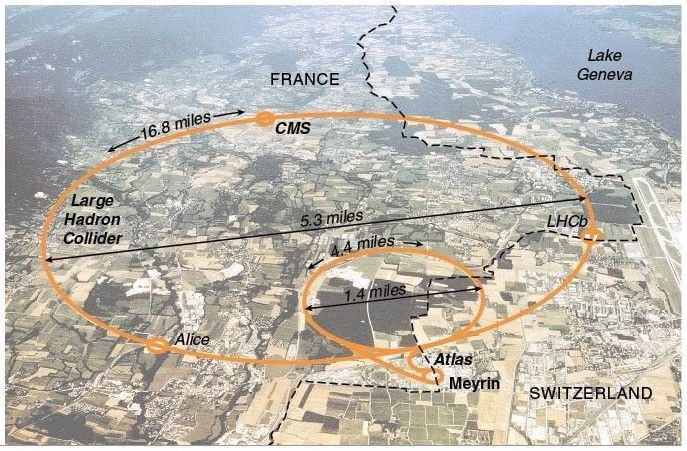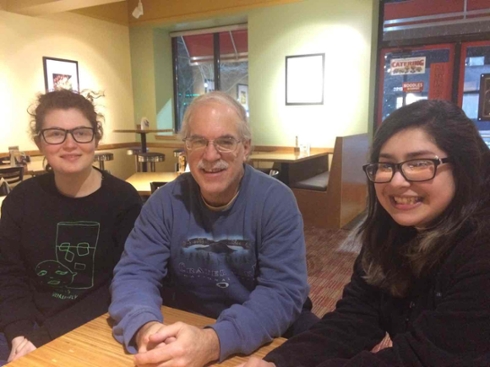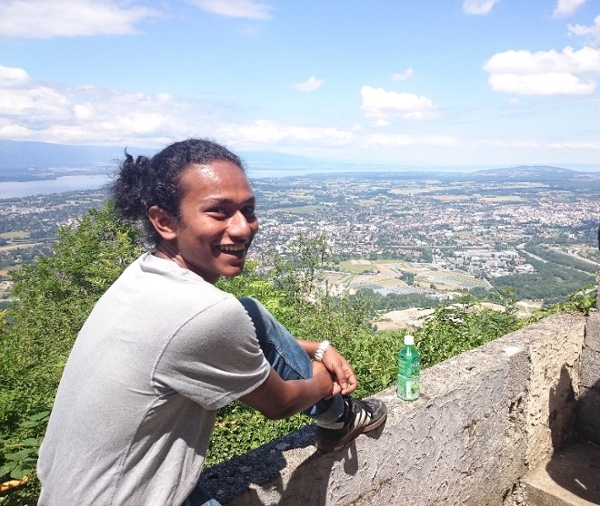Tags
"physics"
PSF: Deep Learning in Experimental High Energy Physics, CERN
I am a little over halfway into my stay at CERN (organisation européenne pour la recherche nucléaire). CERN is the largest particle physics research laboratory in the world and it is spread over two countries - France and Switzerland. There is a main campus that straddles the Franco-Swiss border and there are other facilities above ground, at certain places along the 27 km circumference of the Large Hadron Collider (LHC) which runs between 75-175 m beneath the French and Swiss countryside. The aerial picture below should give you an idea of the size scale of the LHC. The underground tunnel that houses the LHC is approximately 4 meters wide, accommodating many tens of thousands of pieces of equipment. This includes magnets for focusing and directing the particle beams, and cryogenic systems needed to maintain the temperature at about -456.25○ F, which is colder than outer space! CERN is famous for a number of the biggest particle physics discoveries over the past thirty or forty years, at the different experiments that were conducted here, and the creation of the World Wide Web, among other things. In recent times, it has also come into media prominence for the discovery of the Higgs Boson, at the LHC, and misplaced conspiracy theories that generally involve CERN scientists secretly planning to destroy the world.

Aerial outline of the LHC tunnel
However, CERN is more than just the investments in researching physics phenomena, and constructing, improving and maintaining the particle colliders, accelerators, and other laboratory facilities. The people here are just as fascinating as any of the science that they are working on. In the summer months, a large fraction of the 13,000 or more people – users, students, research fellows, etc., associated with CERN are on site for work at the LHC and other experiments. These are some of the very best physicists, engineers and computer scientists in the world, and some of the smartest, funniest and most unpretentious people I’ve ever met. While it does get a little crowded in the summer months, it is a good time to be at CERN because of the huge influx of people from different countries and cultures, and the diversity that this naturally implies. Just sitting in the main cafeteria and talking to other summer students and researchers (including the occasional Nobel Laureate) is such a privilege because of how much you can learn from each conversation. I had never really appreciated the scale of the human endeavor that CERN is until I got here. During my time here, I have realized that no matter your title or rank, you are simply a cog in the giant machine that is CERN. However, each cog is really important! Irrespective of your age, gender identity, nationality or ethnicity, what you say and do will be taken seriously because if you are granted the privilege of working here, it is usually expected that you are capable enough to make a difference. It has been a humbling experience to work in such an environment.
Continue reading PSF: Deep Learning in Experimental High Energy Physics, CERN
Astronomy at the University of Michigan: Lizzy Arellano, Winter Shadow 2016

Going to dinner
The winter shadow that I had the pleasure of going to was far more fulfilling than I ever thought it could be. My hosts were very kind. Their homes were beautiful and their hospitality was very much appreciated. Ann Arbor, Michigan, was one of the most beautiful and easy to get around towns that I’ve ever visited. Mario Mateo’s house was about 2 miles from the University of Michigan, where Sarah and I worked most of the time. We found ourselves really looking forward to the walks every day. Not only was it really nice to pass through the urban and suburban areas of Ann Arbor, but it also gave us an opportunity to explore the downtown more. The food was delicious, the sights were see-worthy, and the snow was puffy. I feel so grateful to have received this externship because I will have otherwise never been able to visit Michigan.
As for the actual project, it was a great experience overall. Not only did I learn a lot of Python, a coding language, but also, I gained experience as an intern. I learned about the actual process of working with a data set and getting real results from my work that could actually contribute to scientific process. Because we were using data from the Magellan Clay Telescope in Chile, where each fiber attached to a plate referred to a specific star in the star cluster, Omega Centauri, we were working off Mateo’s idea of a new way of star cluster analysis. We had to be very careful with our calculations, checking and rechecking for the expected results. We had to generalize our coding, so that when new data comes in, it could be analyzed using the same programs and so that people all over the world would have the opportunity to do the same type of analysis. At the end of our externship, our work rewarded us with a complete spectrum of the stars we analyzed, which allowed Mateo to analyze the spectral lines for different elements contained in the stars.

